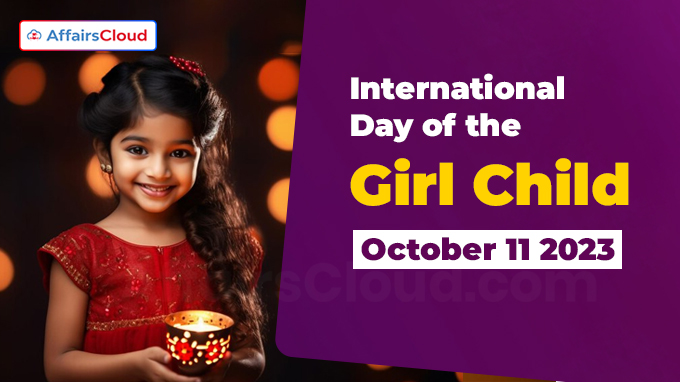
The theme of IDGC 2023 observed on 11th October 2023 is “Invest in Girls’ Rights: Our Leadership, Our Well-being”.
- The theme emphasises the need for the global community to go beyond making commitments and invest boldly in the action needed to empower girls, safeguard their rights, and enhance their well-being.
Background:
i.On December 19, 2011, the United Nations General Assembly (UNGA) adopted a resolution A/RES/66/170 and declared October 11 of every year as the International Day of the Girl Child.
ii.The first International Day of the Girl Child was observed on 11 October 2012.
Beijing Declaration and Platform for Action:
i.In 1995, the World Conference on Women was held in Beijing, China where the UN adopted the “Beijing Declaration and Platform for Action”, themost progressive blueprint ever devised for advancing not only women’s rights but also the rights of girls.
- The Beijing Declaration notably stands out as the first to specifically call out girls’ rights.
Beijing Declaration and Platform for Action, Beijing +5 Political Declaration and Outcome:
This publication also includes the political declaration from the 23rd special session of UNGA in 2000, which reviewed progress toward the Platform for Action 5 years after its adoption.
UN Women Strategic Plan 2022–2025:
UN Women Strategic Plan 2022–2025 sets a vision and roadmap for supporting the achievement of the Sustainable Development Goals(SDGs) by 2030.
- Through this, UN Women leverages its unique triple mandate – encompassing support for norms and standards, UN system coordination and operational work – to mobilize urgent and sustained action to achieve gender equality
Key Facts:
According to the UN:
i.Currently, nearly 1 in 5 girls are still not completing lower-secondary and nearly 4 in 10 girls are not completing upper-secondary school.
ii.Around 90% of adolescent girls and young women in low-income countries do not use the Internet, while their male counterparts are twice as likely to have internet access.
iii.Globally, girls aged 5-14 spend 160 million more hours every day on unpaid care and domestic work than boys of the same age.
iv.Adolescent girls continue to account for 3 in 4 new Human Immunodeficiency Virus (HIV) infections among adolescents.
v.Pregnancy continues to be a significant contributor to adolescent girls’ mortality rates.
- Since 2012, there has been a mere 5% (55% to 60%) increase in the usage of modern family planning methods among adolescent girls.
- 4 out of 10 adolescent girls aged 15-19, who wish to prevent pregnancy, still lack access to or are not using modern contraception.
Investing in Girls:
According to the United Nations Children’s Fund (UNICEF):
i.For every extra year of secondary education, a girl’s potential income rises by 10-20%.
- Investing in girls’ education reduces poverty rates, enhances economic prospects, and improves overall well-being.
ii.Every dollar invested in sexual and reproductive health and rights for adolescent girls can yield economic returns of up to USD 120.
iii.Child marriage is a global issue that demands attention. However, a 2022 review of Official Development Assistance (ODA) reports that only 0.07% of ODA was directed towards combating child marriage.
iv.A 2023 analysis conducted by the Overseas Development Institute concluded that less than 6% of ODA from major bilateral donors is designated for the vital cause of gender and adolescent-focused projects.